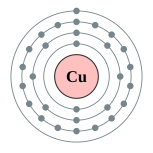Copper
| General properties | |
|---|---|
| Name, symbol, number | copper, Cu, 29 |
| Element category | transition metal |
| Group, period, block | 11, 4, d |
| Standard atomic weight | 63.546(3) |
| Electron configuration | [Ar] 3d10 4s1
2, 8, 18, 1  |
| Discovery | Middle Easterns (9000 BC) |
Copper is a chemical element with the symbol Cu (from Latin: cuprum) and atomic number 29. It is a ductile metal with very high thermal and electrical conductivity. Pure copper is soft and malleable; a freshly exposed surface has a reddish-orange color. It is used as a conductor of heat and electricity, a building material, and a constituent of various metal alloys.
The metal and its alloys have been used for thousands of years. In the Roman era, copper was principally mined on Cyprus, hence the origin of the name of the metal as сyprium (metal of Cyprus), later shortened to сuprum. Its compounds are commonly encountered as copper (II) salts, which often impart blue or green colors to minerals such as turquoise and have been widely used historically as pigments. Architectural structures built with copper corrode to give green verdigris (or patina).Decorative art prominently features copper, both by itself and as part of pigments.
Copper (II) ions are water-soluble, where they function at low concentration as bacteriostatic substances, fungicides, and wood preservatives. In sufficient amounts, they are poisonous to higher organisms; at lower concentrations it is an essential trace nutrient to all higher plant and animal life. The main areas where copper is found in animals are liver, muscle and bone.
Return to Periodic Table
No comments:
Post a Comment